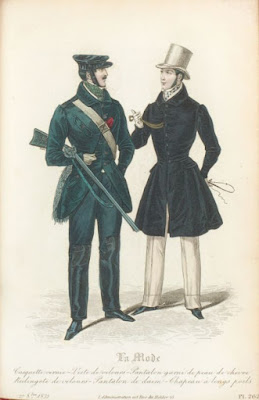Rites of passage have always been opportunities to show off wealth and status. In the 21st century weddings are our favourite occasions for display, but in Victorian times spending money on funerals and mourning dress were equally popular ways of showing off. And given that in the 19th century life expectancy was lower, infant mortality higher, and families larger, there were many (too many) opportunities for wearing mourning.
Not that people necessarily donned mourning only for their nearest and dearest, however. There were carefully regulated graduations of mourning (first mourning, second mourning, half mourning) worn to commemorate everyone from a newly deceased husband to a distant cousin by marriage. At one extreme, a new widow would wear the heaviest mourning with clothes covered in crape (a silk fabric treated to make it lusterless and stiff). At the other the "mourner" would wear fashionable dress in sombre shades.
With all this, it was not surprising that an entire industry sprung up to cater for the mourning needs of the upper and aspiring middle classes. One of the firms which rose to meet this demand was Jay's Mourning Warehouse which was established in 1841 in three large houses on London's Regent Street.
 |
| 1858 |
Jay's introduces its 1858 catalogue, thus:
At the return of the present period, we submit to the public a series of ENGRAVINGS, embodying the Fashions of the Season. It will be observed, that although there is considerable variety of form in the MANTLES here illustrated, they nevertheless preserve that unity for which Parisian invention is remarkable; and it is also well worthy of remark, that in Paris, at the present time, Black and White enjoy a decided favouritism.
In agreement with the requisitions of our Patrons, we have afixed Prices to the costumes, although it will be obvious that these must ultimately depend on the materials employed and the making up. The price, therefore, may be lower, if it be so desired; or it may be higher than that which is given. It is necessary to explain that the subject of the Illustrations are made up in various materials, suitable either for Ladies who adopt Mourning, or for those who wear Black in accordance with the taste of the day.
(The picture above depicts a mantle of cloth trimmed with velvet, a dress of poplin and a bonnet of terry and silk.)
 |
| 1861 |
MOURNING FOR A WIDOWPARAMATTA DRESS, deeply trimmed to the waist with crape.
RADZ-DE-MORT SILK MANTLE, trimmed with crape.
CRAPE BONNET, with deep veil.
TARLATAN CAP, COLLAR AND CUFFS, white.
DINNER DRESS of Radz-de-mort Silk, deeply trimmed with crape.
WHITE LISSE cap.
MOURNING FOR A PARENT
MORNING DRESS of Paramatta, trimmed with two deep tucks of crepe.
CRAPE COLLAR AND CUFFS, OR SLEEVES.
WALKING DRESS of Gros Royal Silk, trimmed deeply with crape. MANTLE to correspond.
CRAPE BONNET, with Black Cap. JET ORNAMENTS.
MOURNING FOR A BROTHER OR SISTER.
MORNING DRESS of French Twill, or Paramatta, with three or five tucks of crape.
BLACK COLLARS AND SLEEVES.
WALKING DRESS of Gros Royal or Berlin Silk, with Mantle to match.
SILK AND CRAPE BONNET.
NET VEIL, with crape hem. JET ORNAMENTS.
SERVANTS' MOURNING
BLACK, OR GREY AND BLACK, GLACE DRESS.
GLACE MANTLE, or GRENADINE SHAWL
WHITE CRAPE OR CHIP BONNET, trimmed with Black.
WHITE NET COLLARS AND SLEEVES.











































